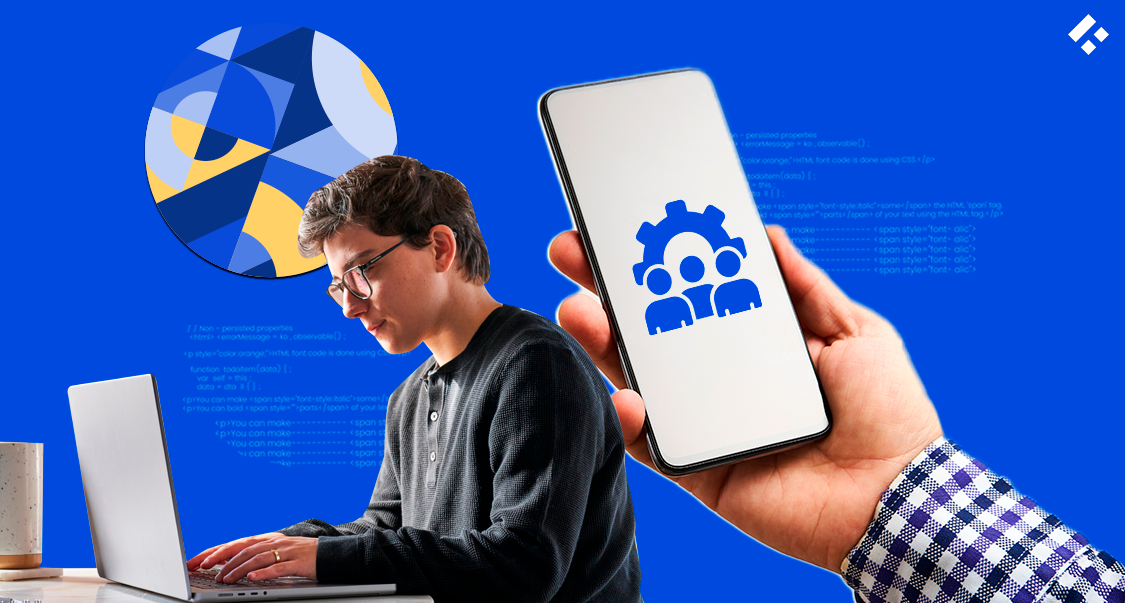Python frameworks provide the basic infrastructure for developing a robust Python software application. Depending on the software project your team is trying to build, there are better and worse Python frameworks suited for its purpose.
Sources demonstrate that Python’s popularity has been steadily increasing in the past decade or so, with approximately 15% of Stack Overflow questions tagged “python” in 2021.
And as such, the corresponding technologies of Python gain similar popularity. It is common to see questions like “What is a Python framework?” or side-by-side Python framework comparisons.
Today, you’ll learn about numerous Python frameworks to use for your software development project. But first, what is a Python framework? Stick around to find out!
Are you ready to start your development project?
We have the developers you need to take your development project in the right direction.
Companies are proven to grow their business faster with Trio.
What Is a Python Framework?
A Python framework, like any framework, cushions your software development project with a foundation or substructure to build on top of. To be clear, software frameworks render the generic functionality of the program you’re trying to create, so your developers don’t have to start from scratch.
Python frameworks in particular, will automate standard application building steps using the Python programming language. As a result, Python developers will save time on development and your business will benefit overall.
Where Is the Use of Python Most Recommended?
Python is a general-purpose, interpreted, object-oriented programming language. The designers of the language prioritized code readability whilst building Python, making the language highly productive.
Readability being an important part of Python’s founding philosophy, Python’s most salient representations of this tenet include its intuitive use of the English language and easily navigable code blocks.
Python’s prime asset is its significant white space, which developers use to isolate code blocks. This tactic encourages easy-to-read code and gives a more friendly appearance to the program compared to other programming languages that use special characters such as brackets.
Released in 1991 by Guido van Rossum, today Python is known as a “batteries included” language because of its large standard library. Python libraries describe pluggable pieces of code that you can work into your program with a simple function call.
The Python Standard Library is what comes with the language right out of the box. This library is notably extensive, with high-level data structures like dictionaries and lists, turtle graphics, and more.
The Python programming language performs well on both the front-end and back-end of development. Moreover, developers use Python to build a variety of software, from web development to machine learning to data science.
Much of Python’s capacity for a diverse array of programming capabilities involves its simplicity and its standard as well as additional libraries.

Python Framework vs. Python Library
Some people wonder about the difference between Python frameworks vs. Python libraries. Although they both offer developers operational functionalities, their similarities end when it comes to specificity and complexity.
For example, Python libraries are filled with dozens of useful functions for specific purposes, but there is not much complexity. Python libraries perform a simple task and are ultimately a small piece of a large puzzle.
Because frameworks work off a specific comprehension of what your application might look like, even more specificity is permissible. Complexity is the name of the game. Thus, a Python framework will outline the puzzle; the more complex the framework, the more outlining of the internal pieces.
The 3 Main Types of Python Frameworks
Python frameworks come in all shapes and sizes. Factors that may affect which framework you choose include scalability, expertise, and your business-specific goals.
Full Stack Framework
Full-stack frameworks are suitable for both back-end and front-end development. Web development consists of front-end tools for graphic user interface (UI) design and back-end services like databases, security protocols, and business logic.
A full-stack Python framework will carry all the equipment you need to facilitate full-stack development. Django is a full-stack framework and is the second most popular Python framework.
Microframework
Microframeworks are by definition lightweight. In some ways, it is the opposite of a full stack framework. Python’s official Flask documentation explains that the “micro” in microframework signifies that the framework’s “core [is] simple, but extensible”.
The components that are fundamental to a full stack framework like a database management system and certain security measures do not come naturally to a microframework.
While this might seem like a bad thing, it actually encourages flexibility for developers who want to leverage control over their software, only adding in the relevant third-party libraries when they’re completely necessary.
Related reading: Ruby vs. Python – Which Programming Language To Choose?
Asynchronous Framework
Asynchronous programs are event-driven. Rather than line by line operational handling where one function runs after the other, asynchronous code is non-blocking and doesn’t wait for one event to execute before starting another.
Because of this parallel programming technique, asynchronous frameworks allow for a profusion of high-performance concurrent connections via running on an async-capable server.
25 Python Frameworks To Use In 2023
In total, there are dozens and dozens of Python frameworks. But since you care about your time, here are 25 Python frameworks that stand out the most.
1. CubicWeb
CubicWeb fits the definition of a full-stack framework. It is also a semantic framework. Semantic technologies rely on ontological and conceptual comprehension to understand data.
Though the typical model-view-controller (MVC) architecture is more commonly in use for developing UIs, CubicWeb uses the concept of cubes. Cubes join together to create an instance with configuration files, a database, and a web server.
2. AIOHTTP
AIOHTTP is an asynchronous framework as well as an HTTP client/server for asyncio. Though some of these words may seem foreign, the gist is that AIOHTTP allows your developers to build asynchronous clients and servers for your web application.
3. Dash
Dash is a microframework best suited for building analysis-oriented Python applications. The framework is a frequent choice for businesses that have stakes in machine learning and data science.
4. Bottle
Bottle is another microframework. Fast and simple, its original design was specified for building application programming interfaces (APIs).
Like the best of microframeworks, Bottle emphasizes its lightweight build, namely by implementing everything into a single source file and relying on few dependencies. Other important features of Bottle include routing, template, utilities, and a built-in HTTP server.
Bottle works closer to hardware than other frameworks. However, you should opt for a more complex framework if you think your program might span longer than 500 lines of code.
5. CherryPy
CherryPy calls itself a minimalist framework. With CherryPy, you can create an entire application using the principles of object-orienting programming. As a result, development is faster and easier.
6. Falcon
Yet another API-oriented framework is Falcon. Falcon is a minimalist microframework geared towards rapid application development. Developers can take advantage of Falcon to build RESTful APIs, app backends, and microservices without the burden of unnecessary abstractions.
7. Django
Django is one of Python’s more popular Python frameworks. Being full stack in nature, Django comes equipped with the tools to build large and complex web applications.
8. Flask
Flask is historically in competition with Django. Django and Flask are the top two most popular Python frameworks. That said, they are wildly different.
Unlike Django, Flask is a microframework and does not hold any tools or functions that a third-party library can fulfill as essential to its packaging.
9. Giotto
Giotto is a Python framework stressing the separation of concerns that the classic MVC architecture elicits. Because of Giotto’s generic implementation of views, models, and multiple pluggable controllers, the framework is a vessel for simplifying and shortening development.
10. Growler
Growler is both an asynchronous framework and a microframework. The framework uses Python’s asynchronous library, asyncio, along with middleware to process HTTP requests.
11. Pylons
Pylons borrows the finest ingredients of Perl, Python, and Ruby to bring to life a full stack framework with a focus on rapid development. Similar to Flask, Pylons is lightweight and flexible.
12. Pyramid
Pyramid is a leading full stack Python framework. Scalability is its biggest asset as small and full-scale applications can depend on Pyramid for their development.
On its official website, Pyramid calls itself a “Goldilocks Solution: not too small, not too big, just right.”
13. Sanic
Sanic shares similarities to Flask, but its asynchronicity makes it even faster than Flask. Benchmark tests show that Sanic can handle tens of thousands of requests per second.
14. Hug
Hug is a microframework for developing APIs. Labeled the fastest framework for Python 3, Hug is paving the way for the technology of the future.
15. Morepath
Dubbed the “Super Powered Python Web Framework”, Morepath is an expressive model-driven microframework providing routing to its models.
Like with MVC patterns, models represent data and views represent the UI. In Morepath, an application consists of models which are routed to a URL path. Content is expressed to the web through views.
16. Pycnic
Pycnic is an object-oriented microframework empowering developers to build APIs based on JSON. JavaScript Object Notation (JSON) is a syntax for manipulating data stored in objects.
17. Tornado
Initially developed to support a social media company named FriendFeed that has since been acquired by Facebook, Tornado is an asynchronous Python framework that can handle several thousand concurrent users at once with a non-blocking network I/O.
18. TurboGears
TurboGears has the versatility for use as a full stack framework or a microframework. The framework is data-driven, user-friendly, and extends a templating engine and an object-relational mapper (ORM).
19. Web2py
Web2py was originally built as a teaching tool, but as a full stack framework, it is loaded with tons of features to do so much more. For instance, there are no requirements for installation and configuration; web2py is cross-platform; and it comes with its own integrated development environment (IDE).
20. FastAPI
FastAPI is a bit self-explanatory. It’s a modern Python framework for building APIs with features to speed up the development process. Much of its design owes it credit to Flask.

Elevate Your Team with Trio AI Talent
Empower Your Projects with Trio’s Elite Tech Teams
21. Grok
Grok leverages important programming principles such as ‘don’t repeat yourself’ (DRY) and ‘convention over configuration’ (CoC) to promote an agile development experience.
DRY strives to reduce repetition by standardizing abstractions. Likewise, CoC aims to decrease the grueling decision-making process for developers by starting them off with a conventional foundation to build up from so they can save time on configuration.
22. BlueDream
BlueBream is a Python framework that is most optimal for building medium and large applications. More than a framework, BlueBream is a server and library too. Some of its best features are its component architecture, transactional object database, and integrated security protocols.
Related reading: Python vs. Java – Side-By-Side Comparison
23. Quixote
Quixote is a simple and flexible Python framework for designing web applications. Anyone with a good knowledge base in Python should thrive with Quixote.
24. Weppy
Weppy — stylized as the lowercased “weppy” — is a full stack Python framework that centers simplicity. Its elegant syntax encourages developers to focus on the product the’re building rather than struggling to navigate the framework itself.
25. Zope
Zope is an application server and web framework. Its primary use case is for the development of content management systems (CMS).

How To Choose the Best Python Framework To Use
Using a Python framework is a sure-fire way to speed up and optimize development. Python frameworks are not a must, but it would also be unwise to neglect the opportunity to enhance your development process where at all possible.
To figure out which Python framework is best for your software project, start by evaluating the different types of frameworks you can choose from. Three major categories of frameworks stand out: full stack frameworks, microframeworks, and asynchronous frameworks.
Microframeworks are small yet flexible; full stack frameworks are complex yet scalable; and asynchronous frameworks amplify Python’s capacity for concurrency.
Once you pick which class of Python frameworks is a good fit, you can narrow your choices down by focusing on the frameworks themselves. Listed above are 25 different frameworks with different capabilities.
You should choose a Python framework based on scalability, speed, your developers’ expertise in deploying framework-specific skills, and a number of other considerations that may be conducive to your business.
Going through each and every Python framework probably isn’t worth your time. But what you’ve learned here can better help you pinpoint exactly what you need.

Conclusion
What is a Python framework? It’s a tool to empower your next Python project, but only if you use the right one.
There are a diverse bunch of Python frameworks out there for you that will give you and your software development team a head start on your 2024 project. The Python framework world is your oyster.
Having a good understanding of how your next project will work, even if you’re not tech-savvy, will be crucial to choosing the optimal tech stack to support your development.
Research is never a bad thing and if you need to consult with some of the more qualified minds in the industry, there’s no shame in it. That’s why Trio is here to help.
Trio can guide you in choosing the best Python framework for your 2022 project as well as build the project itself using the parameters you set.
Contact Trio now to hire the best Senior Python Developers and start your project today!







